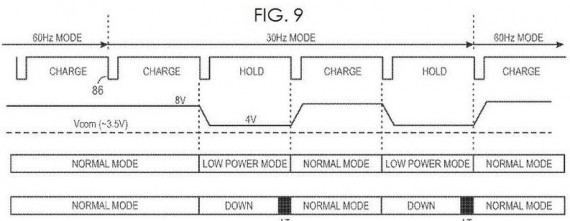Implementarea unui Retina Display in iPad 3 a fortat Apple sa creasca usor grosimea tabletei pentru a implementa doua LED-uri care sa ilumineze ecranul, dar si o baterie de capacitate mai mare. In iPad 4 Apple a eficientizat usor procesul de fabricare al Retina Display-ului, insa abia cu iPad 5 ar fi pregatita sa reduca partial consumul de energie, renuntand la unul dintre LED-urile utilizate pentru iluminare. Totusi Apple nu ar fi multumita de ceea ce are acum, asa ca intr-un brevet de inventie descrie un dispozitiv care ar putea reduce si mai mult consumul de enrgie al Retina Display-urilor sale.
Apple’s latest display invention covers techniques for reducing the power consumption of display devices are provided. In one embodiment, a display device includes a timing controller that may control a rate at which frames are refreshed on a display. The timing controller may cause the frames to refresh at different rates, depending on the image data received at the timing controller. For example, if the image data is not static, the frames may be refreshed at a first rate. However, if the image data is static, the frames may be refreshed at a lower, second rate to reduce the power consumption of the display device.
Dispozitivul descris de catre Apple este un controller care controleaza perioada de timp intre care se efectueaza actualizarea informatiilor despre display, adica un refresh rate controller. Acest dispozitiv ar putea modifica dinamic rata de refresh a ecranului in functie de imaginile afisate pe el, adica in cazul imaginilor statice perioada de refresh ar fi mai mare, in timp ce in cazul celor dinamice ar avea un efect opus. Ideea este de a balansa timpii de refresh pentru a reduce consumul de energie al ecranului, iar asta fara a afecta experienta utilizatorilor.
Avand in vedere ca vorbim despre un brevet de inventie, deocamdata nimeni nu stie cand ar putea ajunge aceasta tehnologie in Retina Display-uri, insa utilizarea sa ar putea reduce cu pana la 50% consumul de energie.






















